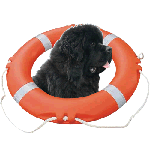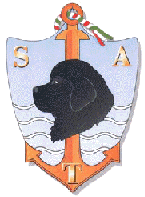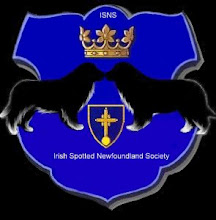Friday, September 29, 2023
Wednesday, September 27, 2023
The Sagacity of the Newfoundland Dog
"No animal, perhaps, can show more real courage than this dog. His perseverance in what he undertakes is so great, that he never relinquishes an attempt which has been enjoined him as long as there is a chance of success. I allude more particularly to storms at sea and consequent shipwreck, when his services, his courage, and indefatigable exertions, have been truly wonderful. Numerous persons have been saved from a watery grave by these dogs, and ropes have been conveyed by them from a sinking ship to the shore amidst foaming billows, by which means whole crews have been saved from destruction. Their feet are particularly well adapted to enable them to swim, being webbed very much like those of a duck, and they are at all times ready to plunge into the water to save a human being from drowning. Some dogs delight in following a fox, others in hunting the hare, or killing vermin. The delight of the Newfoundland dog appears to be in the preservation of the lives of the human race. A story is related on good authority of one of these dogs being in the habit, when he saw persons swimming in the Seine at Paris, of seizing them and bringing hem to the shore. In the immediate neighbourhood of Windsor a servant was saved from drowning by a Newfoundland dog, who seized him by the collar of his coat when he was almost exhausted, and brought him to the banks, where some of the family were assembled watching with great anxiety the exertions of the noble animal.
Those who were much at Windsor, not many years since, must have seen a fine Newfoundland dog, called Baby, reposing occasionally in front of the white Hart Hotel. Baby was a general favourite, and he deserved to be so; for he was very mild in his disposition, brave as a lion, and very sensible. When he was thirsty, and could not procure water at the pump in the yard, he has frequently been seen to go to the stable, fetch an empty bucket, and stand with it in his mouth at the pump till some one came for water. He then, by wagging his tail and expressive looks, made his want known, and had his bucket filled. Exposed as Baby was to the attacks of all sorts of curs, as he slumbered in the sun in front of the hotel, he seemed to think that a pat with his powerful paws was quit sufficient punishment for them, but he never tamely submitted to insult from a dog approaching his own size, and his courage was only equalled by his gentleness.
The following anecdote, which is well authenticated, shows the sagacity as well as the kindliness of disposition of these dogs. In the city of Worcester, one of the principal streets leads by a gentle declivity to the river Severn. One day a child, in crossing the street, fell down in the middle of it, and a horse and cart, which were descending the hill, would have passed over it, had not a Newfoundland dog, rushed to the rescue of the child, caught it up in his mouth, and conveyed it in safety to the foot pavement.
My kind friend, Mr. T, took a Newfoundland dog and a small spaniel into a boat with him on the river Thames, and when he got into the middle of the river, he turned them into the water. They swam different ways, but the spaniel got into the current, and after struggling some time was in danger of being drowned. As soon as the Newfoundland dog perceived the predicament of his companion, he swam to his assistance, and brought him safe to the shore.
A vessel went down in a gale of wind near Liverpool, and every one on board perished. A Newfoundland dog was seen swimming about the place where the vessel was lost for some time, and at last came on shore very much exhausted. For three days he swam off to the same spot, and was evidently trying to find his lost master, so strong was his affection." (Anecdotes of Dogs, by Edward Jesse, Esq.)
Sunday, September 24, 2023
One Man and His Dog: Edward Wix Comes Home
(By William Ellis-Rees)
"There is rather a good story about a missionary and his dog. We feel it fully qualifies for inclusion here as a nineteenth-century story with a London connection. Aside from the two protagonists — the human and the canine — there is a ship and a ship’s captain and a hospital. The joy of the story lies in part in the connections between these unlikely narrative elements.
But first a word on its source. The true fons et origo was William Scott, who was elevated to the peerage as Baron Stowell by George IV for his services to the judiciary. However, it was first written down not by Scott but by Edward Jesse, and Jesse clearly liked the story, for he wrote more than one version of it.
Noble Dogs:
Jesse was a writer on natural history, and, as well as editing Izaak Walton and Gilbert White, he published a little series of books with titles like Scenes and Tales of Country Life and An Angler’s Rambles, in which he set down his many thoughts on the characteristics of animals. They are heavily anecdotal, which lends them charm, even if it denies them scientific rigour.
He was at one time deputy surveyor-general of the royal parks and palaces, a position that must have suited him down to the ground, as it were. But at one time or another he had also been a government clerk, a secretary to a president of the Board of Control and a commissioner of hackney coaches. Quite a life.
Of course what interests us most is Jesse’s passion for dogs, another example of which can be found here. He collected his material from many sources and published it as Anecdotes of Dogs, devoting each chapter to a particular breed. The themes are perhaps rather predictable — loyalty and affection, courage and intelligence — but taken together they add up to a delightful anthology. The engravings, in which a mastiff or a St Bernard or a Scotch collie towers over the landscape, are minor masterpieces. They are heroic portraits of a sort of canine aristocracy.
Serving Abroad:
Back to the story, though. The protagonist, Edward Wix, was an English clergyman. His father, Samuel, was a controversialist with strong published views on such matters as capital punishment, which he opposed. He was also an ordained minister. In practising his vocation, he had as it were shown his son the way.
Whereas Samuel confined his activities to the home front, Edward fought abroad. In his twenties he went out to Canada in the service of John Inglis, who was Bishop of the Diocese of Nova Scotia. As Archdeacon of Newfoundland he was first in Halifax, then in Bonavista and finally, in 1830, in St John’s. In the journal he kept for the year 1835 he described his missionary work among the local ‘Indian’ population. He also made a number of references to his dog.
The Snows Of Nova Scotia:
Sadly we never learn the dog’s name. But it was a faithful companion, enduring much as it followed its master on his perilous journeys in the wintry Nova Scotia landscape. On one such trek, which proved to be more than usually arduous, the dog succumbed to fatigue. On another occasion a tree felled by Wix to feed a camp fire all but killed it. Wix certainly admired the hardiness of the native breed — the Newfoundland, naturally — and it is easy to see why.
When Wix left Nova Scotia and sailed back to England, his trusty helpmeet went with him. If any dog ever suffered the exquisite pain of homesickness, it was the Archdeacon’s dog, watching the coast of eastern Canada grow dimmer on the retreating horizon. The journey that lay ahead was three thousand miles. The North Atlantic was grey and infinitely sad, and the dog, as Edward Jesse pointed out, had never before travelled beyond its native land.
A Theatrical Interlude:
Jesse, like Wix, admired the Newfoundland breed. In the Anecdotes he heaps praise on it, and, although he cannot quite rank it above the Irish Wolfhound, it comes a close second. Among its other fine qualities it has a keen sense of impending danger and a willingness to defend the life of its master at the risk of its own. Endowed by nature with webbed feet — ‘very much like those of a duck’ — it has saved many a seafarer from a watery grave. ‘Some dogs delight in following a fox,’ says Jesse, who of course was writing for a nineteenth-century readership, ‘others in hunting the hare, or killing vermin. The delight of the Newfoundland dog appears to be in the preservation of the lives of the human race.’
Jesse had examples up his sleeve, but really he had no need of them, for the Newfoundland already enjoyed a reputation for saving those in danger of drowning. In 1804 a melodrama with the title The Caravan; or, the Driver and his Dog was staged at the Theatre Royal in Drury Lane. The dog of the title was a real dog, a Newfoundland by the name of Carlo. When Carlo appeared to save a drowning child from a lake, the child, like Carlo, was real.
The water was also real — the producer, Frederick Reynolds, had ‘latterly been amusing himself with water-works’ — although the lake was perfectly artificial. A tank had been built into the stage, and the child was a ‘water boy’ hired for a modest fee and a glass or two of brandy. Depending whose theatrical memoirs you read, the dog belonged to the stage-manager, a fellow by the name of John Bannister, or to a man who ran a beef shop. There was also a rumour that the dog was not a Newfoundland but a mastiff. People were scandalised.
Waiting for Wix:
However, Wix’s Newfoundland was not destined for the London stage. Indeed, one wonders if Wix had any destination for it in mind, for when the ship docked at Blackwall, and he disembarked with his family, he left the dog on board in its kennel. But histories, as Pope once wrote, are ‘more full of examples of the fidelity of dogs than of friends’, and we may well suspect that this particular history does not end there.
And we are right to do so, for a few days later Wix returned to the ship to make arrangements regarding his luggage. By now the ship had been moved upstream to St Katherine’s Docks, and Wix went out to it in a Thames boat moored on the south bank at Borough. He still had no plans for his dog, and so, his business concluded, he climbed back down to the river boat, leaving the companion of his many adventures whimpering in its confinement after its beloved master.Waiting for Wix
However, Wix’s Newfoundland was not destined for the London stage. Indeed, one wonders if Wix had any destination for it in mind, for when the ship docked at Blackwall, and he disembarked with his family, he left the dog on board in its kennel. But histories, as Pope once wrote, are ‘more full of examples of the fidelity of dogs than of friends’, and we may well suspect that this particular history does not end there.
And we are right to do so, for a few days later Wix returned to the ship to make arrangements regarding his luggage. By now the ship had been moved upstream to St Katherine’s Docks, and Wix went out to it in a Thames boat moored on the south bank at Borough. He still had no plans for his dog, and so, his business concluded, he climbed back down to the river boat, leaving the companion of his many adventures whimpering in its confinement after its beloved master.
The Mazy Holborn Streets:
Was it with a heavy heart that Wix was borne away without his faithful hound? We would certainly have it so. But even if man had given up on dog, dog had not given up on man, and the indomitable Newfoundland, somehow freeing itself from its prison, jumped overboard and swam after the river boat as it made its way back to Borough. The first Wix knew of it was when the dog, its coat dripping wet, caught up with him in Tooley Street.
One hopes that Wix was more pleased than annoyed to see his dog. At any rate he let it tag along as he walked over London Bridge and through the City to visit his father, Samuel, who at the time was the resident chaplain of St Bartholomew’s Hospital. The dog waited obediently in the hospital courtyard, and then, when Wix emerged from his father’s house, it tagged along again as he headed off on the next bit of business, which took him through the mazy and menacing streets of Holborn.
A Fine Dog Indeed:
On reaching the other side of Holborn, Wix looked round and to his horror realised that the dog had disappeared. As he poked his nose into one alley after another in search of his lost companion, he understood the significance of a number of recent odd encounters.
Men had come up to him — men he had never met before — to comment on the dog trotting at his heels. ‘Sir, that is a fine dog indeed!’ one would say. ‘It must be worth a great deal!’ another would add. At the time he had thought nothing of it. Now he concluded that the dog had not strayed off into some dingy passage after all. No, the dog had been stolen.
At The Hospital Gates:
Greatly saddened, Wix went on his way. But he had not entirely given up hope, and he sent word to the captain of the ship. He also made up his mind to go back to the hospital in the morning. There was still a chance that the dog had not been stolen but had retraced its steps back to some earlier port of call.
And although he did not know it, he was right, for late that evening the dog suddenly appeared at the gates of St Bartholomew’s Hospital. Some instinct told it that its master was inside — of course his master was not inside — and it howled for him unhappily. The night watchman drove it away, and, when Wix arrived next morning, the dog had gone.
Intelligent And Affectionate:
And now a miracle. Two days later Wix received a message from the docks. Hurrying back to the ship, he found the captain, and, waiting patiently in its kennel, his dog.
The captain told him a remarkable story. Looking out from his ship, he had seen the dog just below him, bobbing up and down in the water. Evidently it had made its way from the hospital right through the City and back over the bridge. Then it had jumped into the river. And guided by nothing other than intelligence and affection — for what scent could there be in the river? — it had identified the ocean-crossing ship on which it had shared its master’s latest grand adventure.
And afterwards? The sagacious Newfoundland was in due course sent to live with Wix’s uncle, one Thomas Poynder, who lived in Clapham hard by the Common. With acres of open land on the doorstep, the dog might be said to have arrived. Then again, given that it had arrived in England from Nova Scotia, we might prefer to say that the dog was now a very, very long way from home. Intelligent and affectionate."
Saturday, September 23, 2023
The Newfoundland - A Water Rescue Dog
“Mrs. Kaye, residing opposite Windsor Park Wall, Datchet, had a beautiful Newfoundland dog. For the convenience of the family a boat was kept, that they might at times cross the water without the inconvenience of going a considerable way round to Datchet Bridge. The dog was so delighted with the aquatic trips, that he very rarely permitted the boat to go without him. It happened that the coachman, who had been but little accustomed to the depths and shallows of the water, intending a forcible push with the punt pole, which was not long enough to reach the bottom, fell over the side of the boat in the deepest part of the water, and in the central part of the current, which accident was observed by a part of the family then at the front windows of the house; sudden and dreadful as the alarm was, they had the consolation of seeing the sagacious animal instantaneously follow his companion, when after diving, and making two or three abortive attempts, by laying hold of different parts of his apparel, which as repeatedly gave way or overpowered his exertions, he then, with the most determined and energetic fortitude, seized him by the arm, and brought him to the edge of the bank, where the domestics of the terrified family were ready to assist in extricating him from his perilous situation.”
(Anecdotes of Dogs - Edward Jesse, Esq. (1858))
Thursday, September 21, 2023
Major - The Heroic Irish Spotted Newfoundland
"On the sixth of October, eighteen hundred and sixty one, as the regiment was on it's way to the seat of war, there came on board the train at Portsmouth, New Hampshire, a large, black, Newfoundland dog, weighing considerably upwards of one hundred pounds. Entering the car occupied by company H, Capt. Emerson, he was adopted by the members of that company and christened 'Major.' From that time until May eight, eighteen hundred and sixty-three, when the regiment was mustered out of service, he continued a member of this company, (never but once deigning to recognize a person belonging to any other, and that during Banks' retreat from Winchester when he became so crippled from continuous travel that it was with the utmost difficulty he could proceed) sharing with almost human patience and fortitude all the vissitudes of camp life, with as much sense of duty, apparently, as if he had been duly enlisted and mustered for the war. Major went on to serve with the 29th Maine, where he was killed at the Battle of Mansfield Landing in Louisiana."
Monday, September 18, 2023
The Dog From Newfoundland - Ever Faithful In Life And Death
In a retelling of the incidents at Pittsburgh Landing (also known as Shiloh) "Private John K. Ferguson, company K, Sixty-fifth Ohio, who was killed in the second day's battle, was accompanied to camp by a young Newfoundland dog, who had persistently followed him from the time of his enlistment, and from camp to camp, to the moment of his death. Two days after the battle the faithful dog was found lying upon the inanimate breast of his master; nor would he consent to leave the spot until the remains were buried."
Saturday, September 16, 2023
Water Rescue Newfoundland Pup Tows 2,800 Pound Pontoon Boat Back To Safety In Choppy Pennsylvania Waters
(The Daily Mail)
"A water rescue trained dog saved a boat that had been pulled off course by a strong current and choppy waters in a Beltzville, Pennsylvania lake.
Oakley, the Newfoundland who trains with the American Academy of Canine Water Rescue in Massachusetts, executed the impressive rescue just before a storm rolled in.
'We swam out and Oakley took the mooring rope in his mouth and turned that big pontoon into the current and pulled it all the way to her walking depth!' wrote George Abraham, who runs Oakley's Instagram account: @that_nepa_newfie.
In the video, Oakley can be seen in her doggy rescue goggles and gear, dragging a boat many times her size and weight out of the lake's current against a backdrop of growing storm clouds.
Oakley was trained by the American Academy of Canine Water Rescue in Southborough, Massachusetts and is one of just two dogs in the United States that is trained using the methods of the Scuola Italiana Cani da Salvataggio - the Italian counterpart to the American Academy.
Water rescue dogs, which include breeds such as Newfoundlands, German shepherds and golden retrievers, are taught how to execute rescues off of boats, jet skis, and even out of helicopters.
Newfoundland Dogs, as well as Labrador Retrievers and certain other breeds, were specifically bred to rescue people in the water.
'When this natural instinct is enhanced via clear training, bonding techniques with a human handler then the dog/human team becomes beyond compare as a rescue entity for people in danger of drowning,' reads the Academy's website.
Oakley appears to spend most of her year training for various water rescue demonstrations and event around the world."
Thursday, September 7, 2023
Lives Transformed By Swimming With Newfoundand Dogs
(The Week UK - September 7, 2023)
"Paramedic Pete Lewin is transforming the lives of firefighters, police officers and soldiers suffering from PTSD by taking them swimming with his Newfoundland dogs. Those taking part in the therapy put on a dry suit and a lifejacket, and wade into the middle of a lake in Leicestershire, where they float on their backs in silence. When their time is up, they are 'rescued' by a Newfoundland: the dog swims out to them, before gently towing them back to shore. 'The dogs don’t judge you,' said Kevin Robinson, who did four tours in Northern Ireland during the Troubles. 'All they want to do is look after you. It keeps me happy for two to three days.'”
Sunday, September 3, 2023
Ship Carrying Newfoundland Dog That Sank Over 140 Years Ago Found In Nearly Pristine Condition With Crew’s Possessions Still Present
(New York Post - September 2, 2023)
"The schooner Trinidad was discovered 270-feet deep in Lake Michigan off the coast of Algoma, Wis., by historians Brendon Baillod and Bob Jaeck.
'The wreck is among the best-preserved shipwrecks in Wisconsin waters with her deck-house still intact, containing the crew’s possessions and her anchors and deck gear still present,' they said in a statement.
The boat sank in the lake in 1881. Baillod and Jaeck found it in July, using survivor accounts and historical records, then side-scan sonar, to home in on the vessel’s location.
Despite the passage of time, the vessel was in nearly pristine condition: the ship’s wheel was found on the seafloor without a piece missing. The main portion of the boat was intact, with the poles detached. The deck house only had a nick in the roof, but the main structure remained largely untouched.
The 140-foot schooner – similar to a sailboat with extra sails – was primarily used in the grain trade between Milwaukee, Chicago, and Oswego, New York.
It’s final journey occurred May 11, 1881, as the Trinidad was carrying coal to Milwaukee and suffered a leak while traveling through the Sturgeon Bay Ship Canal. The boat sank 10 miles off the coast of Algoma, 'taking all the crew’s possessions and the captain’s pet Newfoundland dog with her,' according to the news release.
Captain John Higgins believed the hull had been damaged while the ship traversed ice fields in the Straits of Mackinac.
All nine passengers – including the captain – survived. They rowed eight hours in the yawl boat to shore.
The original owners of the boat did not maintain it, causing its value to plummet. Insurance records show the Trinidad being valued at $22,000 in 1867, but by 1878, it was only worth half of that, Baillod said in a news release.'
The hull had begun to leak and the captain nearly died when a block fell from the rigging. By 1879, the boat was no longer fit for carrying grain cargoes and it was sold.
By May 1880, the boat was commissioned to to take coal to the mines on Silver Islet in Lake Superior – a route the older vessels had never taken. It struck a reef on its way to the pier, tearing out 10 feet of the bottom.
The boat was hastily salvaged and put back into service, Baillod said.
It was sent out for what was supposed to be its final voyage, but the captain stopped halfway to wait out the winter. It sank shortly after resuming its journey.
Baillod and Jaeck started their search for the Trinidad – which was built in New York in 1867 – two years ago. Baillod became interested in the shipwreck while constructing a database of all the known shipwrecks in Wisconsin waters, Baillod said.
The historians believed the shipwreck 'ticked all the boxes' for discovery, as the crew had given a good description where the Trinidad sank and the boat sank slowly – meaning there was a good chance it was still in one piece.
After referring to historical ship lane records, alongside the crew’s description of where it sank, Baillod was able to determine a search area of roughly one-third of a mile.
They nearly missed the wreck on the sonar, but after going over the area again, they discovered the ship.
A second team confirmed the wreck after taking measurements of the hull.
The two historians are working with the Wisconsin Historical Society to nominate the site as a National Register of Historic Places."
Subscribe to:
Posts (Atom)






































































